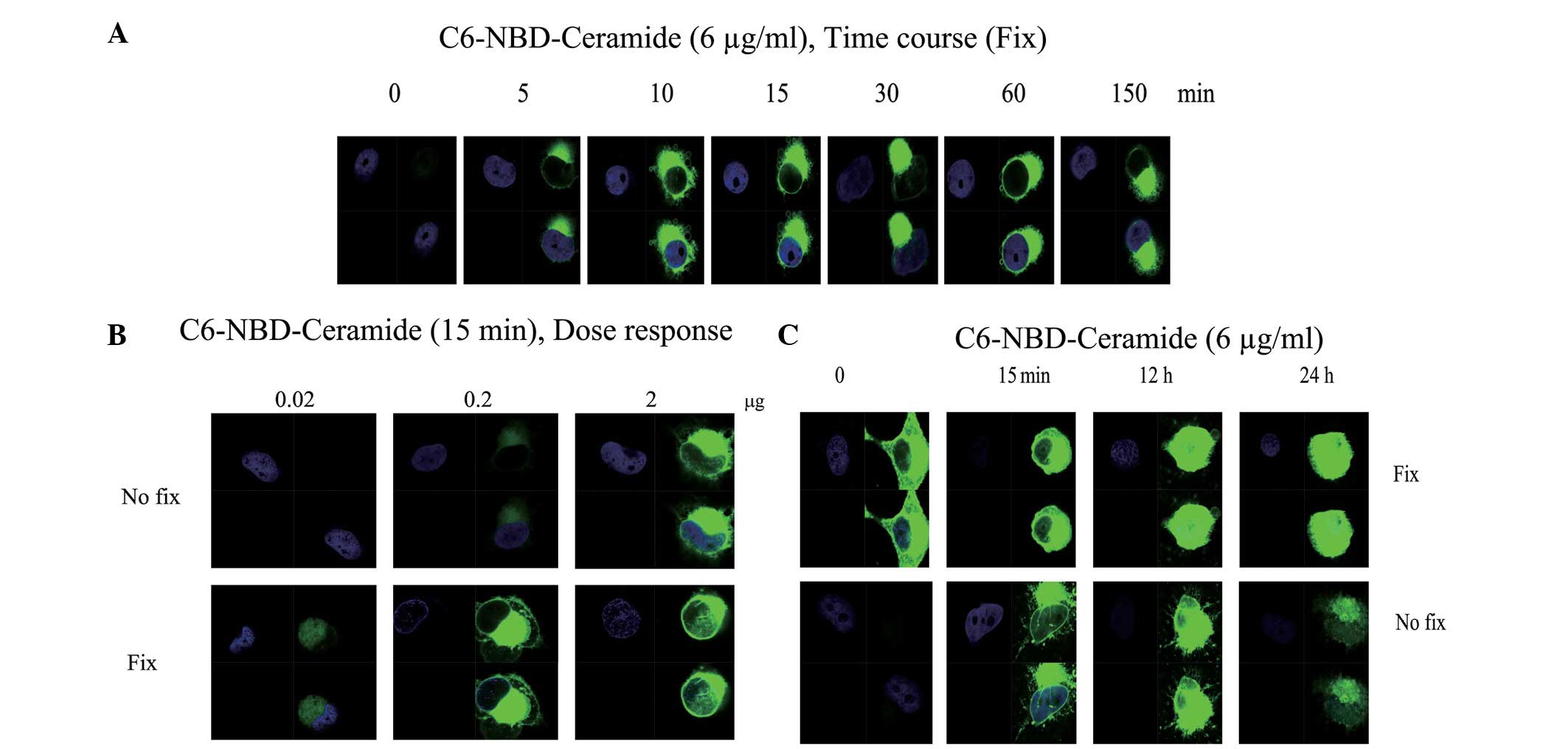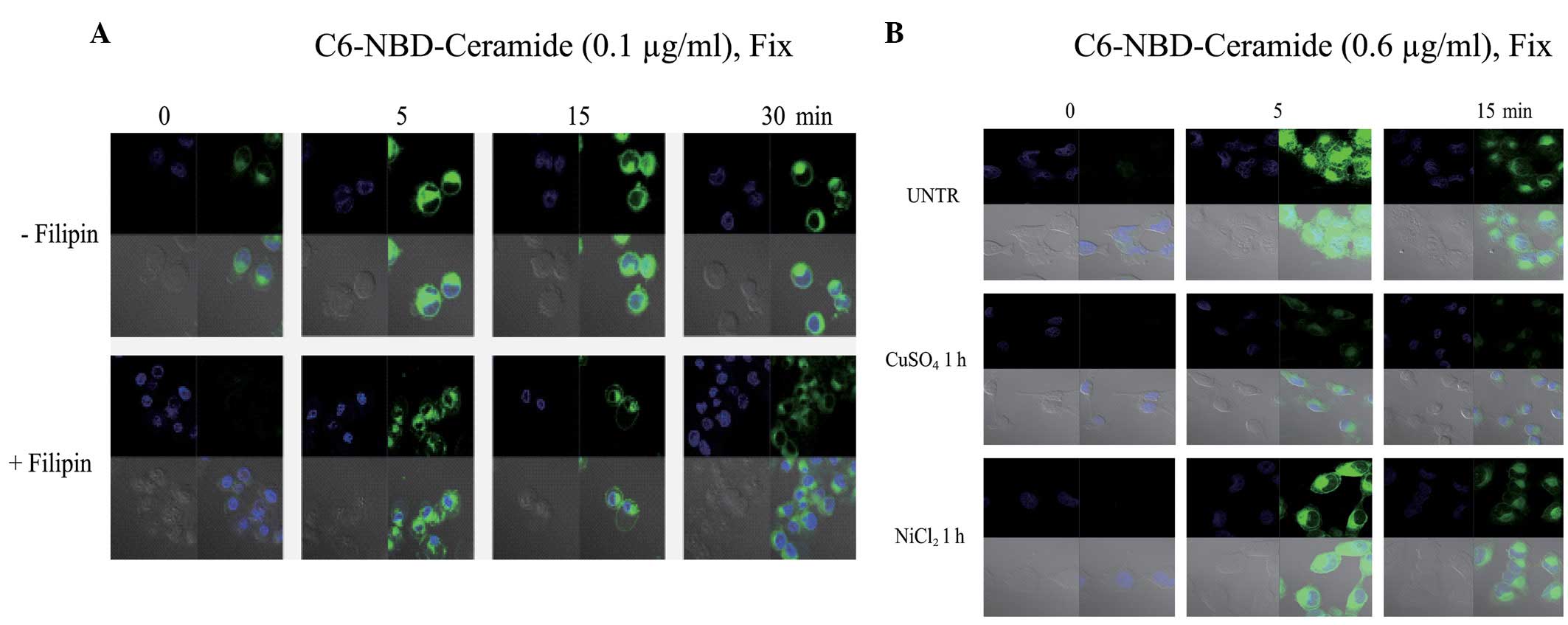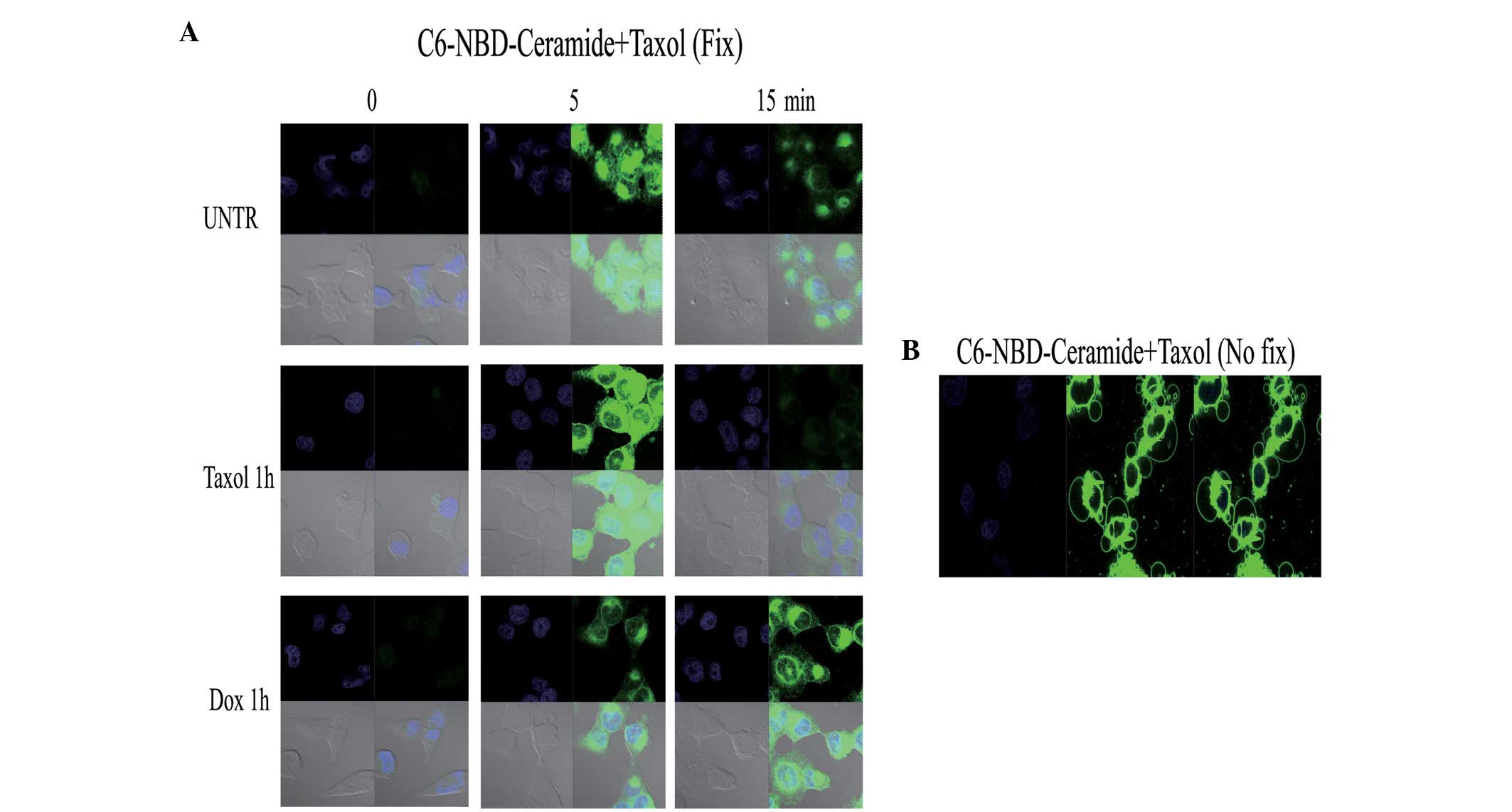|
1
|
Bourteele S, Hausser A, Döppler H,
Horn-Müller J, Röpke C, Schwarzmann G, Pfizenmaier K and Müller G:
Tumor necrosis factor induces ceramide oscillations and negatively
controls sphingolipid synthases by caspases in apoptotic Kym-1
cells. J Biol Chem. 273:31245–31251. 1998. View Article : Google Scholar
|
|
2
|
Zhan D, Santin AD, Liu Y, Parham GP, Li C,
Meyers C and Hermonat PL: Binding of the human papillomavirus type
16 p97 promoter by the adeno-associated virus Rep78 major
regulatory protein correlates with inhibition. J Biol Chem.
274:31619–31624. 1999. View Article : Google Scholar : PubMed/NCBI
|
|
3
|
Chapman JV, Gouazé-Andersson V, Messner
MC, Flowers M, Karimi R, Kester M, Barth BM, Liu X, Liu YY,
Giuliano AE and Cabot MC: Metabolism of short-chain ceramide by
human cancer cells - implications for therapeutic approaches.
Biochem Pharmacol. 80:308–315. 2010. View Article : Google Scholar : PubMed/NCBI
|
|
4
|
Lavie Y, Cao HT, Volner A, Lucci A, Han
TY, Geffen V, Giuliano AE and Cabot MC: Agents that reverse
multidrug resistance, tamoxifen, verapamil and cyclosporin A, block
glycosphingolipid metabolism by inhibiting ceramide glycosylation
in human cancer cells. J Biol Chem. 272:1682–1687. 1997. View Article : Google Scholar
|
|
5
|
Chang MS, Sasaki H, Campbell MS, Kraeft
SK, Sutherland R, Yang CY, Liu Y, Auclair D, Hao L, Sonoda H,
Ferland LH and Chen LB: HRad17 colocalizes with NHP2L1 in the
nucleolus and redistributes after UV irradiation. J Biol Chem.
274:36544–36549. 1999. View Article : Google Scholar : PubMed/NCBI
|
|
6
|
Lucci A, Giuliano AE, Han TY, Dinur T, Liu
YY, Senchenkov A and Cabot MC: Ceramide toxicity and metabolism
differ in wild-type and multidrug-resistant cancer cells. Int J
Oncol. 15:535–540. 1999.PubMed/NCBI
|
|
7
|
Giussani P, Bassi R, Anelli V, Brioschi L,
De Zen F, Riccitelli E, Caroli M, Campanella R, Gaini SM, Viani P
and Riboni L: Glucosylceramide synthase protects glioblastoma cells
against autophagic and apoptotic death induced by temozolomide and
Paclitaxel. Cancer Invest. 30:27–37. 2012. View Article : Google Scholar : PubMed/NCBI
|
|
8
|
Lucci A, Han TY, Liu YY, Giuliano AE and
Cabot MC: Modification of ceramide metabolism increases cancer cell
sensitivity to cytotoxics. Int J Oncol. 15:541–546. 1999.PubMed/NCBI
|
|
9
|
Carlier MF and Pantaloni D: Taxol effect
on tubulin polymerization and associated guanosine 5′-triphosphate
hydrolysis. Biochemistry. 22:4814–4822. 1983.
|
|
10
|
Myrick D, Blackinton D, Klostergaard J,
Kouttab N, Maizel A, Wanebo H and Mehta S: Paclitaxel-induced
apoptosis in Jurkat, a leukemic T cell line, is enhanced by
ceramide. Leuk Res. 23:569–578. 1999. View Article : Google Scholar : PubMed/NCBI
|
|
11
|
Gatei M, Young D, Cerosaletti KM,
Desai-Mehta A, Spring K, Kozlov S, Lavin MF, Gatti RA, Concannon P
and Khanna K: ATM-dependent phosphorylation of nibrin in response
to radiation exposure. Nat Genet. 25:115–119. 2000. View Article : Google Scholar : PubMed/NCBI
|
|
12
|
Charles AG, Han TY, Liu YY, Hansen N,
Giuliano AE and Cabot MC: Taxol-induced ceramide generation and
apoptosis in human breast cancer cells. Cancer Chemother Pharmacol.
47:444–450. 2001. View Article : Google Scholar : PubMed/NCBI
|
|
13
|
Liu Y, Qiu L and Li C: Effect of radiation
on nasal mucosa and the microvascular casting of guinea pig. Lin
Chuang Er Bi Yan Hou Ke Za Zhi. 20:793–796. 2006.(In Chinese).
|
|
14
|
Devalapally H, Duan Z, Seiden MV and Amiji
MM: Paclitaxel and ceramide co-administration in biodegradable
polymeric nanoparticulate delivery system to overcome drug
resistance in ovarian cancer. Int J Cancer. 121:1830–1838. 2007.
View Article : Google Scholar : PubMed/NCBI
|
|
15
|
Kolesnick R, Altieri D and Fuks Z: A
CERTain role for ceramide in taxane-induced cell death. Cancer
Cell. 11:473–475. 2007. View Article : Google Scholar : PubMed/NCBI
|
|
16
|
Swanton C, Marani M, Pardo O, Warne PH,
Kelly G, Sahai E, Elustondo F, Chang J, Temple J, Ahmed AA, Brenton
JD, Downward J and Nicke B: Regulators of mitotic arrest and
ceramide metabolism are determinants of sensitivity to paclitaxel
and other chemotherapeutic drugs. Cancer Cell. 11:498–512. 2007.
View Article : Google Scholar : PubMed/NCBI
|
|
17
|
Lee AJ, Roylance R, Sander J, Gorman P,
Endesfelder D, Kschischo M, Jones NP, East P, Nicke B, Spassieva S,
Obeid LM, Birkbak NJ, Szallasi Z, McKnight NC, Rowan AJ, Speirs V,
Hanby AM, Downward J, Tooze SA and Swanton C: CERT depletion
predicts chemotherapy benefit and mediates cytotoxic and
polyploid-specific cancer cell death through autophagy induction. J
Pathol. 226:482–494. 2012. View Article : Google Scholar
|
|
18
|
Qiu L, Zhou C, Sun Y, Di W, Scheffler E,
Healey S, Wanebo H, Kouttab N, Chu W and Wan Y: Paclitaxel and
ceramide synergistically induce cell death with transient
activation of EGFR and ERK pathway in pancreatic cancer cells.
Oncol Rep. 16:907–913. 2006.PubMed/NCBI
|
|
19
|
Kuebler WM, Yang Y, Samapati R and Uhlig
S: Vascular barrier regulation by PAF, ceramide, caveolae and NO -
an intricate signaling network with discrepant effects in the
pulmonary and systemic vasculature. Cell Physiol Biochem. 26:29–40.
2010. View Article : Google Scholar
|
|
20
|
Hara-Chikuma M, Chikuma S, Sugiyama Y,
Kabashima K, Verkman AS, Inoue S and Miyachi Y: Chemokine-dependent
T cell migration requires aquaporin-3-mediated hydrogen peroxide
uptake. J Exp Med. 209:1743–1752. 2012. View Article : Google Scholar : PubMed/NCBI
|
|
21
|
Virreira M, Perret J and Delporte C:
Pancreatic beta-cells: Role of glycerol and aquaglyceroporin 7. Int
J Biochem Cell Biol. 43:10–13. 2011. View Article : Google Scholar : PubMed/NCBI
|
|
22
|
Zheng X and Bollinger Bollag W: Aquaporin
3 colocates with phospholipase d2 in caveolin-rich membrane
microdomains and is downregulated upon keratinocyte
differentiation. J Invest Dermatol. 121:1487–1495. 2003. View Article : Google Scholar : PubMed/NCBI
|
|
23
|
Cao C, Sun Y, Healey S, Bi Z, Hu G, Wan S,
Kouttab N, Chu W and Wan Y: EGFR-mediated expression of aquaporin-3
is involved in human skin fibroblast migration. Biochem J.
400:225–234. 2006. View Article : Google Scholar : PubMed/NCBI
|
|
24
|
Ji C, Cao C, Lu S, Kivlin R, Amaral A,
Kouttab N, Yang H, Chu W, Bi Z, Di W and Wan Y: Curcumin attenuates
EGF-induced AQP3 up-regulation and cell migration in human ovarian
cancer cells. Cancer Chemother Pharmacol. 62:857–865. 2008.
View Article : Google Scholar : PubMed/NCBI
|
|
25
|
Kelland LR: Emerging drugs for ovarian
cancer. Expert Opin Emerg Drugs. 10:413–424. 2005. View Article : Google Scholar : PubMed/NCBI
|

















